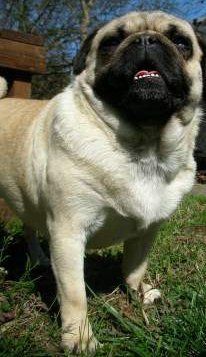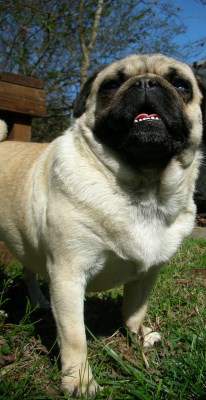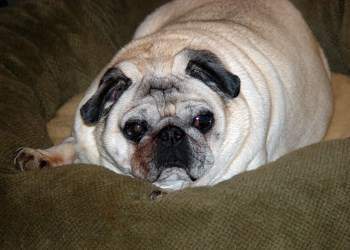Weight

Pug Dog Weight | Overweight Pugs
Overview
It's not uncommon for owners to be concerned and worried that they have a fat and overweight Pug. They remember that rather trim adolescent and the next thing that they know, they look at their older Pug and wonder if they somehow got out of shape.
If this is indeed the case, steps should be taken to help a Pug slim down. However, many Pugs are incorrectly classified as being overweight.
Let us first remember that the Pug is an unusual and unique dog. This is true for many reasons, however the one that we are going to talk about here is the shape of the dog.
There are, of course, many different shapes of dogs... the lean sleek look of a Pointer or a short haired Chihuahua.... the muscled look of the Boxer... the delicate look of the Papillon.
The set genetic physical appearance of any certain dog not only dictates certain qualities such as length of snout or expected size, it also dictates the very body structure of the canine.
So, What Shape is a Pug?
The Pug has a barrel (or log) shaped body. And because of this, the adult Pug will never have a lean, sleek appearance.
Even when the dog has a low percent of body fat and is completely healthy in every way, he or she is going to look like a Pug; And this means that they will be short, thick and stout.
This is part of what makes this breed so adorable looking. Some say that the Pug is so ugly that it is cute. We disagree! We, and many owners all around the world, appreciate this breed for what it is and can appreciate the beauty in that wrinkled up face, round body, short legs and curled up tail.
Why Pugs Become Overweight
While all adult Pugs will have a short, beefy, wide-chested and barrel shaped body, this breed can additionally be prone to packing on excess weight.
This happens due to a combination of the following factors:
1) Overeating -
This breed often has a very hearty appetite and most are not that picky about food. They can and often do gulp down anything given to them.
2) Low exercise tolerance -
Due to being a brachycephalic breed and with short legs, the Pug is often not able to exercise as his long-snouted, long legged counterparts. When you add on possible breathing problems during hot, humid weather, a Pug can become overweight when his calorie intake exceeds the amount of fuel that his body burns off.
3) Age -
As a Pug matures into a senior, there is a gradual decrease in metabolism. A senior needs less calories per day than an adult, though the appetite often remains the same. This can cause a small amount of weight gain each month that adds up over the course of a couple of years.


How Much a Pug Should Weigh
The AKC breed standard tells us that the 'ideal' Pug will weigh between 14 and 18 pounds (6.35 and 8.16 kg) for both males and females.
*
It should be noted that this was not always the case; the AKC's
previous weight standard separated the genders with the preferred weight for males being 13 to 20 pounds (5.89 to 9.07 kg) and females being between 13 and 18 pounds (6-8 kg) if female.
The FCI
(Fédération Cynologique Internationale), CKC
(Canadian Kennel Club) and KC
lists ideal weight to be 6.3 kg to 8.1 kg (13.88 to 17.85 lbs.) for both genders. Along with this, they are sure to note that the Pug 'should be hard of muscle but substance must not be confused with overweight'.
How Much Pugs Really Weigh
Despite the 'ideal' standards, a pet Pug can weigh more than this and not be considered overweight. While a healthy weight is determined by several factors including age and individual body structure, a Pug may be up to 21 pounds (9.52 kg) when fully grown and not have a weight problem.
With this said, once a Pug tops 22 pounds (9.97 kg) and more, it will be time to evaluate a possible weight issue.
If you notice that your Pug is over expected weight during the second half of the first year of growth- even before he reaches his final size - you may need to evaluate things at that time.
Here is a general guideline:
Puppies should never be put on a diet. It is expected for them to have a round appearance and extra fat helps them maintain proper sugar levels and regulate body temperature. There will be starts and stops, but generally you want to see an increase over that first year. 8 week old pups
will be between 2 and 4 pounds (.90 and 1.81 kg), and gaining a bit each day. By the 6 month mark,
a Pug will be between 7 and 12 pounds (3.17 and 5.44 kg). If a Pug is much heavier than this, he/she should be checked by the veterinarian for possible weight issues.
At just around 9 months old, growth will slow down. A Pug will still gain a few more pounds over the course of the next 3 to 4 months, but is very close to his/her final weight. By the 1 year mark, a Pug should be at his final adult weight, give or take 1 or 2 lbs. (.45 or .90 kg). If a Pug continues to gain after this age, this is a red flag that he/she is becoming overweight.
Ways to Know if a Pug is Overweight
It would be great to tell you the exact amount of weight that your dog should weigh. However, there are many variables... gender, age, body structure (i.e. big bones, etc), and metabolism. You can have a 14 lb. (6.35 kg) adult Pug and a 21 lb. (9.52 kg) adult Pug that are both at a healthy weight.
1)
The best way to know if your Pug is carrying too many pounds is to have him/her evaluated at the veterinarian's office.
Aside from that, here are some guidelines::
2) If a female adult is 19 pounds (8.61 kg) or more and if a male adult Pug is 22 pounds (9.97 kg) or more.

3)
When attempting to feel the rib cage, there is a thick layer of fat that prevents you from feeling the bones.
4)
The dog is visibly heavy. Sometimes owners do not notice and it takes a unbiased 3rd party to point it out. Very overweight Pugs will clearly have too much fat, giving them a very bloated (and uncomfortable) appearance.
5)
A Pug that is carrying too much weight will begin to struggle with mobility issues. Going up steps, climbing onto the sofa and other normal activities will become difficult.
With such short legs, extra fat around the chest, belly, shoulders and back will interfere with his ability to walk and play as he used to.
The Ways in Which Being Overweight is Detrimental to a Pug
We all know that being at a healthy weight is... well, healthy! But many owners wonder why. For a Pug, excess weight can can often does severely affect his overall
health and even cuts his
life expectancy by years. It's bad for a Pug to be overweight for several reasons:
1) Breathing problems will become worse -
With extra fat all around the neck, chest and face this impedes breathing even more than it already is for this brachycephalic breed.
2) Strain on the body -
Carrying extra pounds puts a terrible strain on the bones and joints. Knees, hips and back are all affected. Pugs that are too heavy will have joint damage, bone and ligament damage.
3) Disease -
Dogs that are obese have increased risk of many health problems including diabetes, liver and kidney diseases, Intervertebral disc disease and even cancer. Often, there is too much stress on the heart.
4) Skin & Coat -
The Pug already can have skin issues due to folds in the coat that can harbor bacteria. If overweight, skin and coat problems only get worse.
5) Life span -
A dog's life span is automatically reduced by a range of 8 months to up to 2 years if he/she is obese; however this is nothing compared to the decrease in quality of life that an overweight Pug endures.
How to Help a Pug Dog Lose Weight Safely
One of the elements that comes into play and makes this a bit of a challenge is that in order to lose, a dog should ingest less calories and exercise to burn more. With a Pug, exercise is not easy; With existing or potential breathing issues, it can be very dangerous to push this dog to run a mile with you... Or to play Frisbee for an hour. Not only can they have trouble breathing during these activities, they can also overheat very easily.
Here are some tips to help your Pug lose weight:
1) Health check -
Your Pug should have a complete veterinary examination to check for any weight related health issues or other health problems. Some issues such a high blood pressure may need to be controlled with prescribed medication as part of a healthy plan to get your dog back on track.
2) Feeding -
This breed has a hard time with a decrease in food. The best way to help a Pug lose weight is to offer the same amount of food yet have it contain fewer calories.
You can do this by switching your Pug's current dog food formula to a low-calorie formula. This may be labeled as 'healthy weight' or 'low fat'. For example, Wellness Complete Small Breed Healthy Weight
 is the low-calorie option for the Wellness line, which is highly recommended.
is the low-calorie option for the Wellness line, which is highly recommended.
Another way to offer the same amount of food is to switch out some of the higher calorie kibble for lower calorie ingredients, such as certain vegetables and certain fruits. Good choices include green beans, spinach, kale, blueberries, and raspberries.
Remember that a good portion of a Pug's calorie consumption is in the snacks he is given, generally 20 to 30% of the day's intake. There are many healthy snacks for Pugs that can take the place of heavy calorie-laden treats. In fact, Fruitables Skinny Minis Dog Treats
 is a line of super-tasty treats with just 2 to 3 calories a piece and there are lots of awesome flavors like pumpkin and mango, pumpkin and berry, and pumpkin and apple.
is a line of super-tasty treats with just 2 to 3 calories a piece and there are lots of awesome flavors like pumpkin and mango, pumpkin and berry, and pumpkin and apple.
3) Activity - You'll want to take a look at your dog's regular exercise routine and begin by adding an extra 5 minutes to his daily walking time. As long as the vet gives the 'go ahead', each week, this should be increased by 5 minutes until his normal walking time each day is doubled.
For example, if you normally took your Pug for one 20-minute walk, the goal will be to add on 5 minutes per week for a final walking time of 40 minutes per day. This can be split up into two 20 minute walks or a 30 minute walk in the morning and a shorter 10 minute jaunt in the evening.
Be sure to increase duration, not the pace. If a Pug, and particularly an overweight one, is forced to exert himself too much, this can cause heavier breathing, increased heart rate and strain on the body. Keeping at a pace that is brisk for the Pug is all that is needed, taking breaks as needed.
Finally, be sure to use a harness
for your Pug - which should be done at any rate - since the tension of a collar on leash will be more constricting than ever.
How Fast a Pug Should Lose Weight
A slow yet gradual loss should be the goal since fast weight loss can only be accomplished by food deprivation and overexertion in the exercise department. A reduction of .5 to 1 pound (.22 to .45 kg) per month is a reasonable goal for Pugs that need to lose 5+ pounds (2.26 + kg).
Pug Dog Before and After Weight Loss Photos
This is Gabby, a female Pug owned by Mike and Bernadette, that lost 20 pounds! This was done over the course of 4 months, from November 2015 to February 2016. Note: Before photo was at age 7. After photos are at 8 years old. And this Pug turns 9 in February 2017.

Before: 40 pounds

After: These 3 photos are at 20 lbs. after a 20 lb loss.


Mike and Bernadette helped their Pug lose these 20 lbs. by switching her to a diet dog food and importantly cutting out table scraps and instead offering raw baby carrots (very low calorie and healthy!). Once in a while, she would share her owner's Caesar salads (another low calorie, health choice).
Since Gabby was already walking 3 to 4 times per day, exercise was not increased. This Pug has maintained her weight loss for just about a year now and is bound to have a much healthier and more comfortable life.
Tips to Help a Pug Maintain His New Healthy Weight
Once you put in the effort to bring your Pug back down to a healthy weight, you'll need to work to keep him there. It's easy to slip back into bad habits and all that effort will have been in vain. Here's some tips:
1)
Keep in mind that your new, longer exercise sessions with your dog are the new 'norm' and should be followed each day. In fact, once your Pug is no longer carrying excess weight, you'll find that he may be more open to new activities such as hiking around a lake, exploring the coast and generally enjoying the outdoors more than ever.
2)
Never reward your Pug for eating healthy by offering a 'cheat treat' or a 'cheat day'. It's never a good idea to remind a dog about an unhealthy snack that tasted great once he is used to his new, healthier eating plan. Rewards can be praise, toys or even a new game that you play together.
PetPugDog.com Copyright 2019. All rights reserved. Privacy Policy
We are a participant in the Amazon Services LLC Associates Program, an affiliate advertising program designed to provide a means for us to earn fees by linking to Amazon.com and affiliated sites.

